A CFO-Assisted Algorithm for Wireless Time-Difference-of-Arrival Localization Networks: Analytical Study and Experimental Results
Abstract
1. Introduction
- We propose a CFO-assisted TDoA localization algorithm, which is able to synchronize the anchor nodes with only a single message from a broadcaster node;
- On top of localization information, our proposed method is also able to provide information about the movement of the target, even with a single message from the target node;
- The error of the proposed algorithms is investigated analytically and a closed-form solution is proposed;
- A set of controlled lab experiments is realized to validate our previous findings;
- An extensive outdoor vehicular measurement campaign is conducted to validate and quantify the performances of the proposed algorithms.
2. Materials and Methods
2.1. System Model
2.1.1. TDoA Architecture
2.1.2. LO Model
2.2. TDoA without Synchronization
2.3. Broadcaster-Assisted TDoA
2.4. CFO-Assisted TDoA and Velocity Estimation
2.4.1. CFO-Assisted TDoA Estimate
2.4.2. Variance of TDoA Error
2.4.3. Localization
2.4.4. Velocity Estimation
| Algorithm 1: Velocity estimation | ||
| Data: N anchors, | ||
| Result: position and velocity of a moving target | ||
| 1 | foreach anchor i do | |
| 2 | measure the ToA () and CFO () of the last broadcaster packet; | |
| 3 | measure the ToA () and CFO () of the current target packet; | |
| 4 | compute (21) | |
| 5 | compute (14); | |
| 6 | end | |
| 7 | Solve the TDoAs system generated from (15) using [18] to determine the target location | |
| 8 | Solve (22) to estimate the target velocity | |
2.5. Simulation and Experimental Setup
2.5.1. Simulation Setup
2.5.2. Lab Setup
2.5.3. Roadside Setup
3. Results
3.1. TDoA Estimation
3.1.1. Errors
- Imperfect clock model and different time resolutions, explaining the significant difference at .
- Lack of clock diversity in the lab setup, containing only six LOs in an identical environment. This explains the plateau in broadcaster-assisted results.
3.1.2. Variance
3.2. Localization
3.3. Velocity
4. Discussion
5. Conclusions
Author Contributions
Funding
Institutional Review Board Statement
Informed Consent Statement
Data Availability Statement
Acknowledgments
Conflicts of Interest
Abbreviations
| TDoA | Time Difference of Arrival |
| ToA | Time of Arrival |
| OTA | Over-The-Air |
| eCDF | empiral Cumulative Distribution Function |
| GPS | Global Positioning System |
| RF | Radio Frequency |
| MR | Major Road |
| RJ | Road Junction |
| RA | Roundabout |
| SDR | Software Defined Radio |
| SNR | Signal to Noise Ratio |
| GNSS | Global Navigation Satellite Systems |
| CFO | Carrier Frequency Offset |
| LO | Local Oscillator |
Appendix A
Appendix B
References
- del Peral-Rosado, J.A.; Granados, G.S.; Raulefs, R.; Leitinger, E.; Grebien, S.; Wilding, T.; Dardari, D.; Lohan, E.S.; Wymeersch, H.; Floch, J.J.; et al. Whitepaper on New Localization Methods for 5G Wireless Systems and the Internet-of-Things; IRACON, 2018; pp. 1–27. Available online: https://re.public.polimi.it/bitstream/11311/1069386/2/2018_white_paper_IRACON-WP2.pdf (accessed on 18 January 2024).
- Fisher, K.A.; Raquet, J.F.; Pachter, M. Cooperative Estimation Algorithms Using TDOA Measurements. In Cooperative Systems: Control and Optimization; Grundel, D., Murphey, R., Pardalos, P., Prokopyev, O., Eds.; Springer: Berlin/Heidelberg, Germany, 2007; pp. 57–66. [Google Scholar] [CrossRef]
- Tahat, A.; Kaddoum, G.; Yousefi, S.; Valaee, S.; Gagnon, F. A Look at the Recent Wireless Positioning Techniques With a Focus on Algorithms for Moving Receivers. IEEE Access 2016, 4, 6652–6680. [Google Scholar] [CrossRef]
- Win, M.Z.; Conti, A.; Mazuelas, S.; Shen, Y.; Gifford, W.M.; Dardari, D.; Chiani, M. Network localization and navigation via cooperation. IEEE Commun. Mag. 2011, 49, 56–62. [Google Scholar] [CrossRef]
- Zhu, H.; Zhu, J.; Jiang, B. Sub-sample high-resolution TOA estimation algorithm for LTE downlink. In Proceedings of the 2017 IEEE 9th International Conference on Communication Software and Networks (ICCSN), Guangzhou, China, 6–8 May 2017; pp. 939–942. [Google Scholar] [CrossRef]
- Patwari, N.; Ash, J.; Kyperountas, S.; Hero, A.; Moses, R.; Correal, N. Locating the nodes: Cooperative localization in wireless sensor networks. IEEE Signal Process. Mag. 2005, 22, 54–69. [Google Scholar] [CrossRef]
- Serrano, J.; Cattin, M.; Gousiou, E.; van der Bij, E.; Wlostowski, T.; Daniluk, G.; Lipinski, M. The White Rabbit Project; IBIC: Oxford, UK, 2013. [Google Scholar]
- Sanz Subirana, J.; Juan Zornoza, J.; Hernández-Pajares, M. GNSS Data Processing, Volume I: Fundamentals and Algorithms; ESA Communications: Noordwijk, The Netherlands, 2013. [Google Scholar]
- Hafeez Chaudhary, M.; Scheers, B. Practical One-Way Time Synchronization Schemes with Experimental Evaluation. In Proceedings of the 2018 IEEE 19th International Workshop on Signal Processing Advances in Wireless Communications (SPAWC), Kalamata, Greece, 25–28 June 2018; pp. 1–5. [Google Scholar] [CrossRef]
- Mahmood, A.; Ashraf, M.I.; Gidlund, M.; Torsner, J. Over-the-Air Time Synchronization for URLLC: Requirements, Challenges and Possible Enablers. In Proceedings of the 2018 15th International Symposium on Wireless Communication Systems (ISWCS), Lisbon, Portugal, 28–31 August 2018; pp. 1–6. [Google Scholar] [CrossRef][Green Version]
- Ebadi, Z.; Hannotier, C.; Steendam, H.; Horlin, F.; Quitin, F. An over-the-air CFO-assisted synchronization algorithm for TDOA-based localization systems. In Proceedings of the 2020 IEEE 92nd Vehicular Technology Conference (VTC2020-Fall), Victoria, BC, Canada, 18 November–16 December 2020; pp. 1–5. [Google Scholar] [CrossRef]
- Grisales Campeón, J.P.; Fierens, P.I. Joint position and clock tracking of wireless nodes under mixed LOS-NLOS conditions. Phys. Commun. 2022, 54, 101803. [Google Scholar] [CrossRef]
- Xiong, H.; Chen, Z.; Yang, B.; Ni, R. TDOA localization algorithm with compensation of clock offset for wireless sensor networks. China Commun. 2015, 12, 193–201. [Google Scholar] [CrossRef]
- Chan, Y.T.; Ho, K.C. A simple and efficient estimator for hyperbolic location. IEEE Trans. Signal Process. 1994, 42, 1905–1915. [Google Scholar] [CrossRef]
- Compagnoni, M.; Pini, A.; Canclini, A.; Bestagini, P.; Antonacci, F.; Tubaro, S.; Sarti, A. A Geometrical-Statistical Approach to Outlier Removal for TDOA Measurements. IEEE Trans. Signal Process. 2017, 65, 3960–3975. [Google Scholar] [CrossRef]
- Yu, W.; Gaubitch, N.D.; Heusdens, R. Distributed Tdoa-Based Indoor Source Localisation. In Proceedings of the 2018 IEEE International Conference on Acoustics, Speech and Signal Processing (ICASSP), Calgary, AB, Canada, 15–20 April 2018; pp. 6887–6891. [Google Scholar] [CrossRef]
- Picard, J.S.; Weiss, A.J. Time difference localization in the presence of outliers. Signal Process. 2012, 92, 2432–2443. [Google Scholar] [CrossRef]
- Hannotier, C.; Horlin, F.; Quitin, F. A geometry-based algorithm for TDoA-based localization in the presence of outliers. In Proceedings of the 2023 IEEE Wireless Communications and Networking Conference (WCNC), Glasgow, UK, 26–29 March 2023; pp. 1–6. [Google Scholar] [CrossRef]
- IEEE Std 802.11-2016 (Revision of IEEE Std 802.11-2012); IEEE Standard for Information Technology—Telecommunications and Information Exchange between Systems Local and Metropolitan Area Networks—Specific Requirements—Part 11: Wireless LAN Medium Access Control (MAC) and Physical Layer (PHY) Specifications. IEEE: Piscataway, NJ, USA, 2016; pp. 1–3534. [CrossRef]
- Schmidl, T.; Cox, D. Robust frequency and timing synchronization for OFDM. IEEE Trans. Commun. 1997, 45, 1613–1621. [Google Scholar] [CrossRef]
- Sourour, E.; El-Ghoroury, H.; McNeill, D. Frequency offset estimation and correction in the IEEE 802.11a WLAN. In Proceedings of the IEEE 60th Vehicular Technology Conference, 2004. VTC2004-Fall. 2004, Los Angeles, CA, USA, 26–29 September 2004; Volume 7, pp. 4923–4927. [Google Scholar] [CrossRef]
- Dasala, K.P.; MacDonald, W.M.; Samardzija, D. Synchronized Uplink Time of Arrival Localization: A Measurement-driven Evaluation. In Proceedings of the 2020 IEEE 92nd Vehicular Technology Conference (VTC2020-Fall), Victoria, BC, Canada, 18 November–16 December 2020; pp. 1–6. [Google Scholar] [CrossRef]
- Zucca, C.; Tavella, P. The clock model and its relationship with the Allan and related variances. IEEE Trans. Ultrason. Ferroelectr. Freq. Control 2005, 52, 289–296. [Google Scholar] [CrossRef] [PubMed]
- Bidigare, P.; Pruessing, S.; Raeman, D.; Scherber, D.; Madhow, U.; Mudumbai, R. Initial over-the-air performance assessment of ranging and clock synchronization using radio frequency signal exchange. In Proceedings of the 2012 IEEE Statistical Signal Processing Workshop (SSP), Ann Arbor, MI, USA, 5–8 August 2012; pp. 273–276. [Google Scholar] [CrossRef]
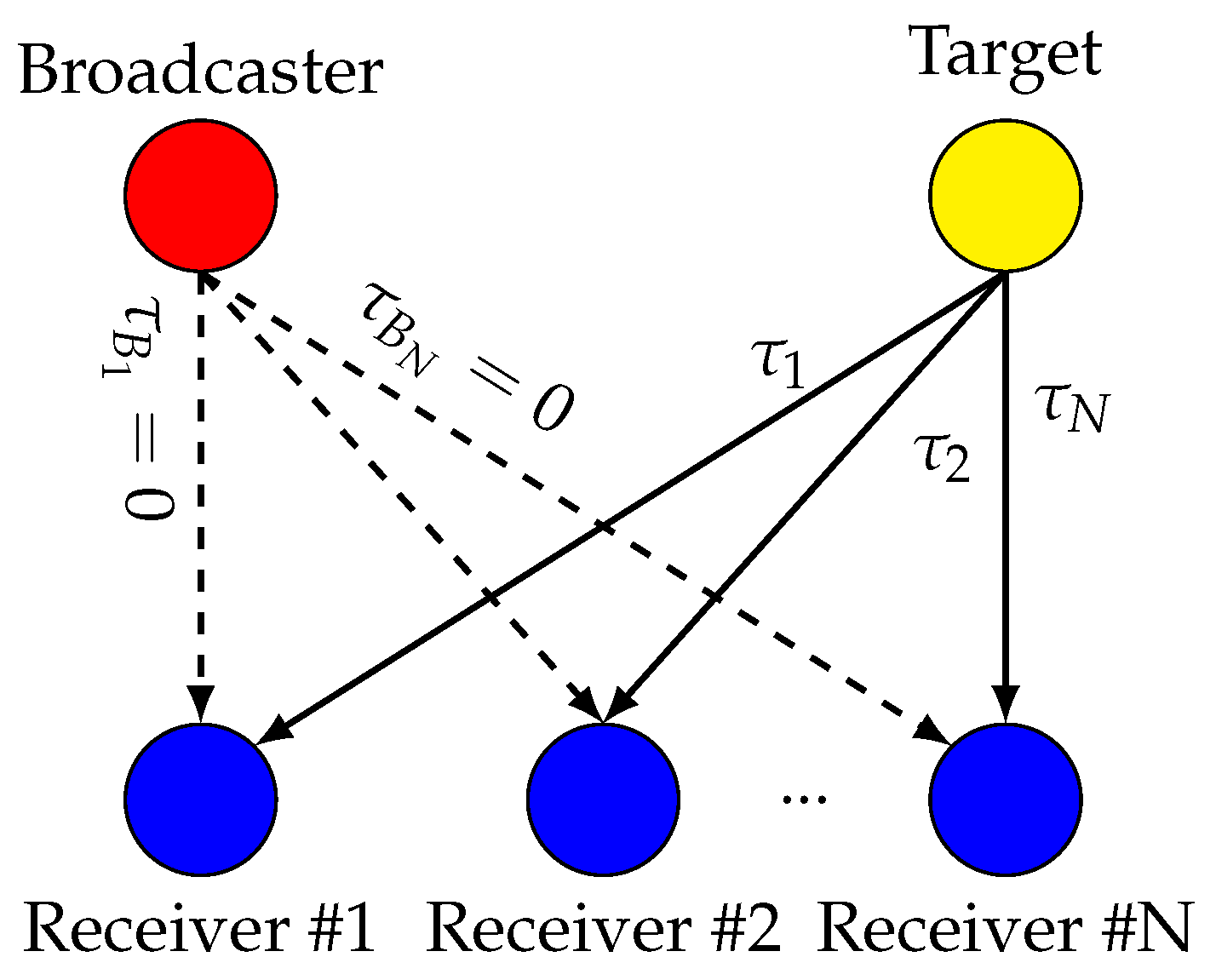
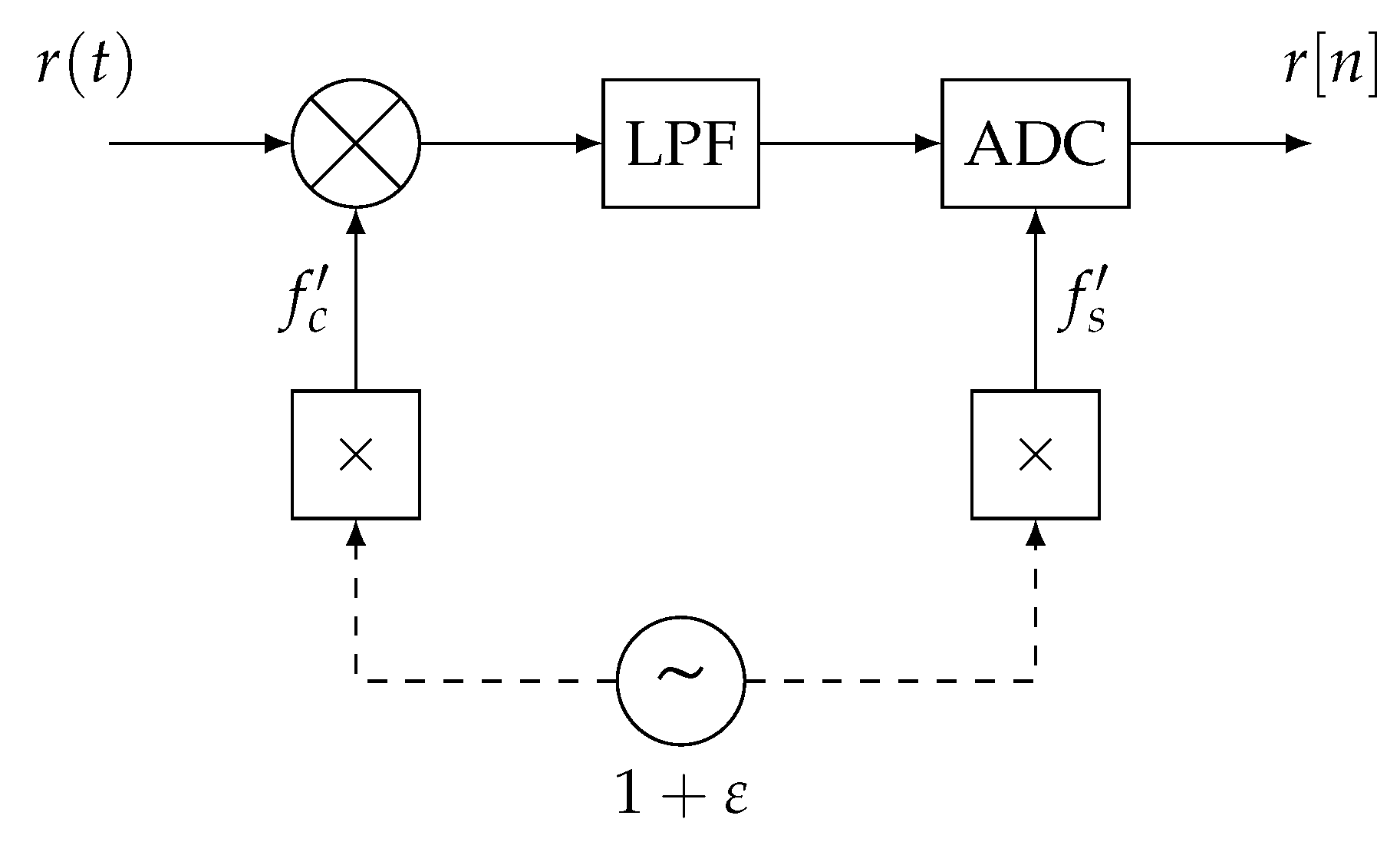
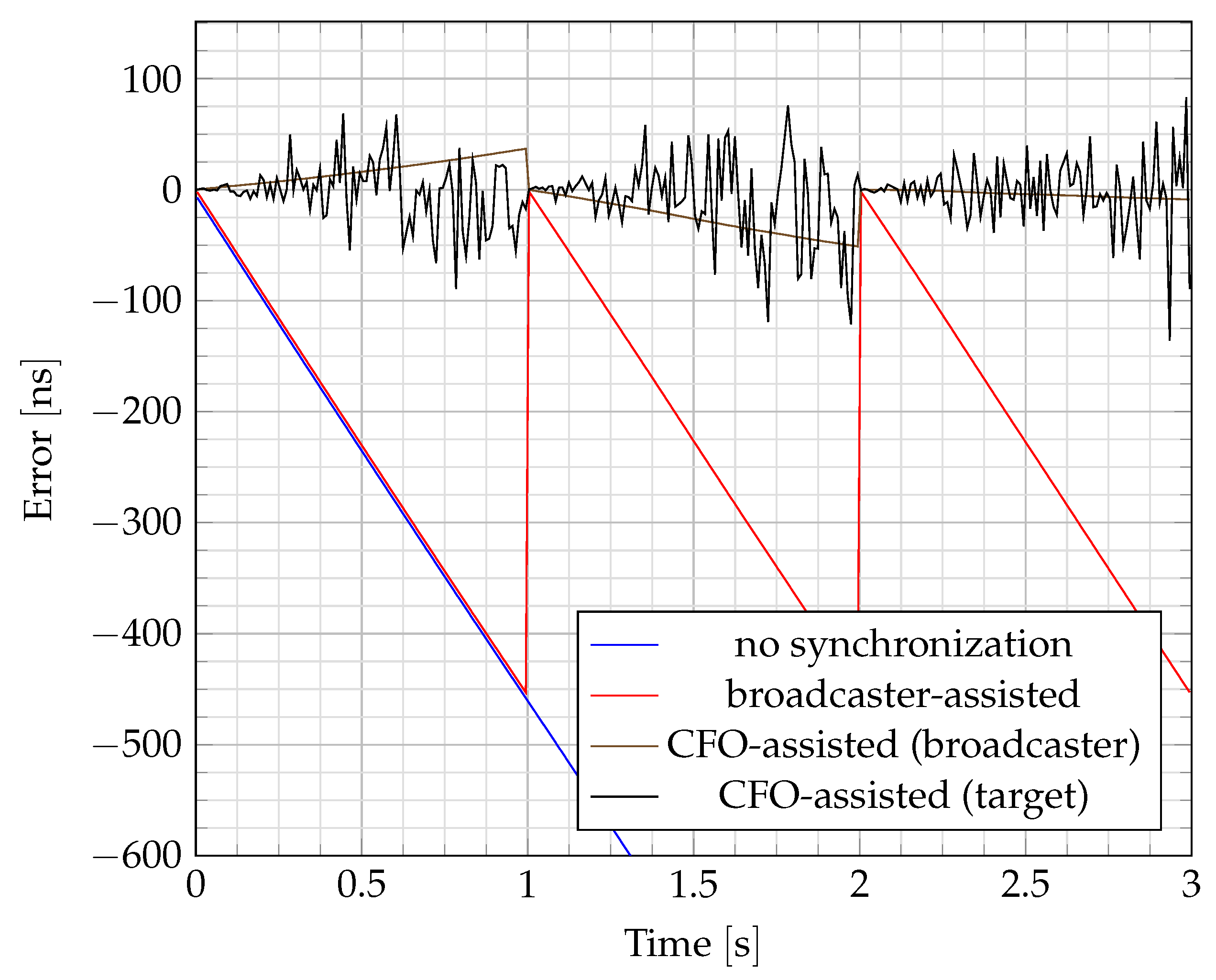
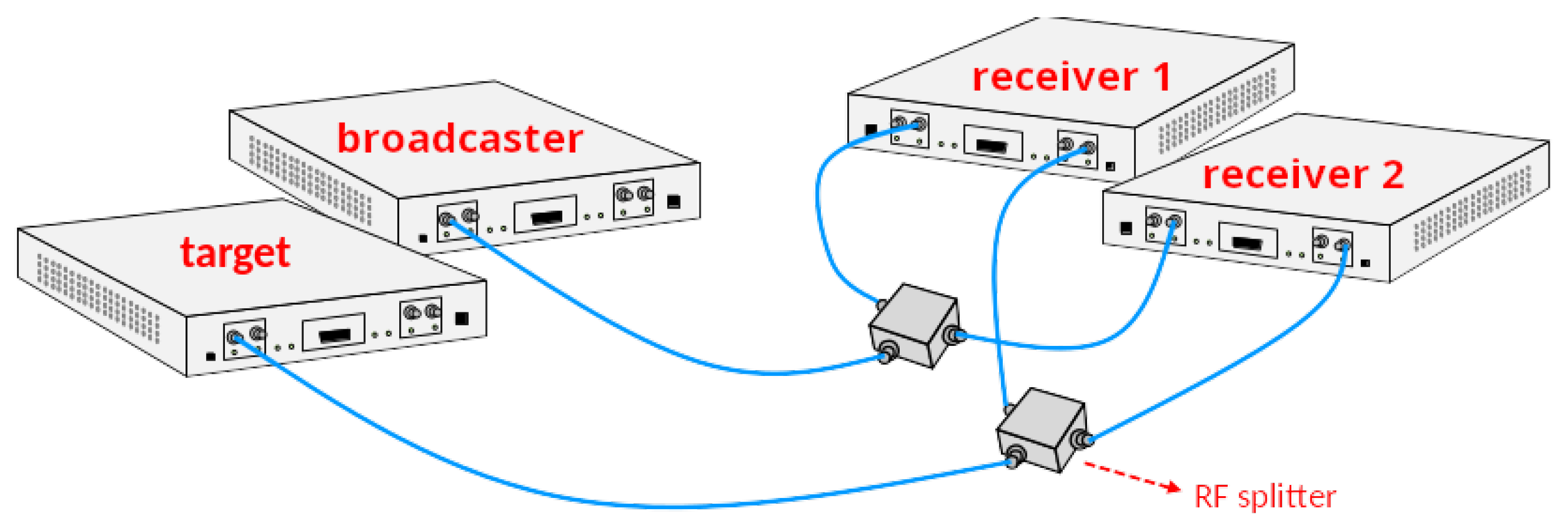
 are the receivers,
are the receivers,  is the broadcaster and
is the broadcaster and  are the targets.
are the targets.
 are the receivers,
are the receivers,  is the broadcaster and
is the broadcaster and  are the targets.
are the targets.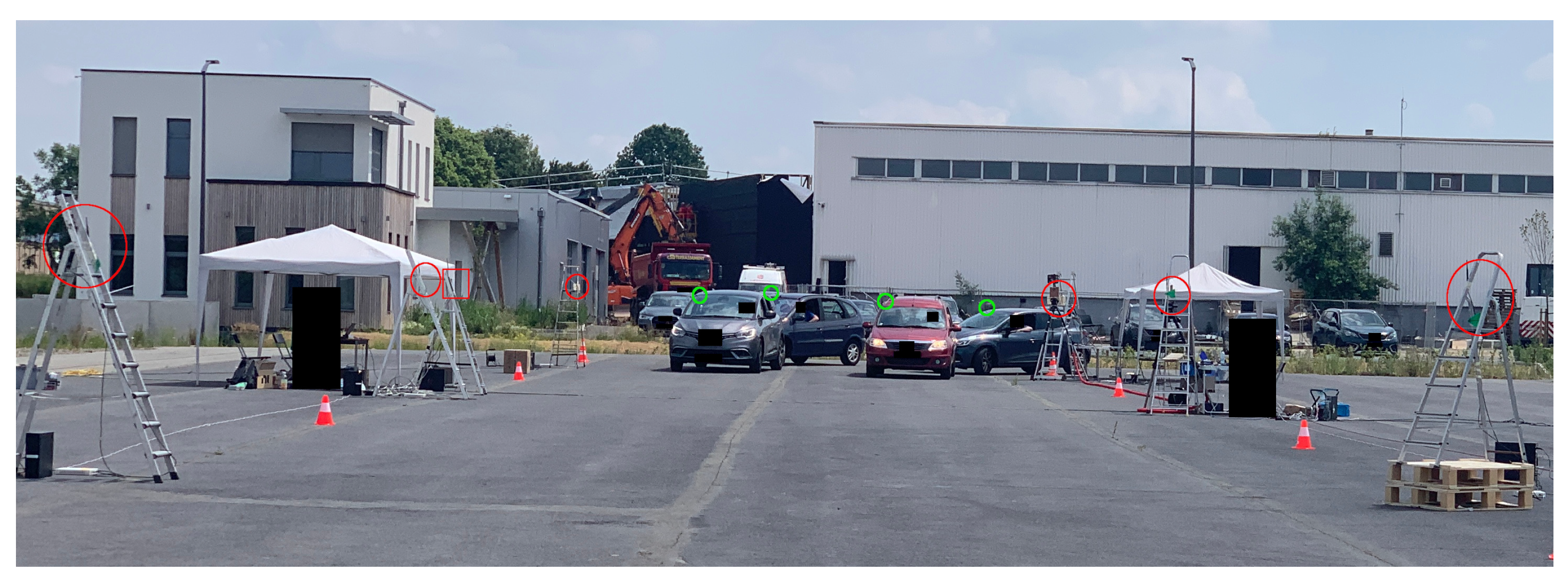
 ) and 1 broadcaster (
) and 1 broadcaster ( ). The devices are placed above ground. (a) Map for Major Road (MR) scenarios. (b) Map for Road Junction (RJ) scenarios. (c) Map for Roundabout (RA) scenarios.
). The devices are placed above ground. (a) Map for Major Road (MR) scenarios. (b) Map for Road Junction (RJ) scenarios. (c) Map for Roundabout (RA) scenarios.
 ) and 1 broadcaster (
) and 1 broadcaster ( ). The devices are placed above ground. (a) Map for Major Road (MR) scenarios. (b) Map for Road Junction (RJ) scenarios. (c) Map for Roundabout (RA) scenarios.
). The devices are placed above ground. (a) Map for Major Road (MR) scenarios. (b) Map for Road Junction (RJ) scenarios. (c) Map for Roundabout (RA) scenarios.
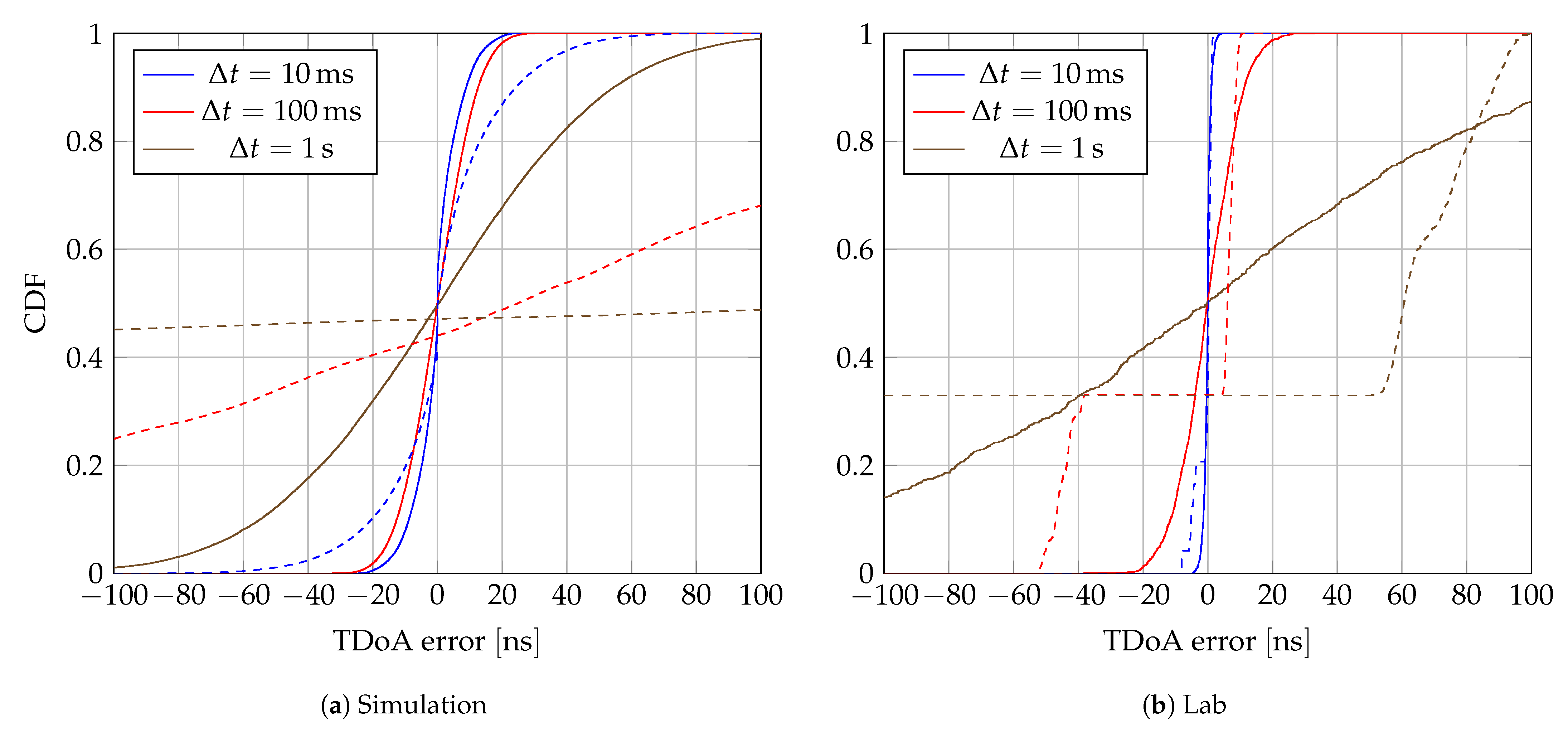
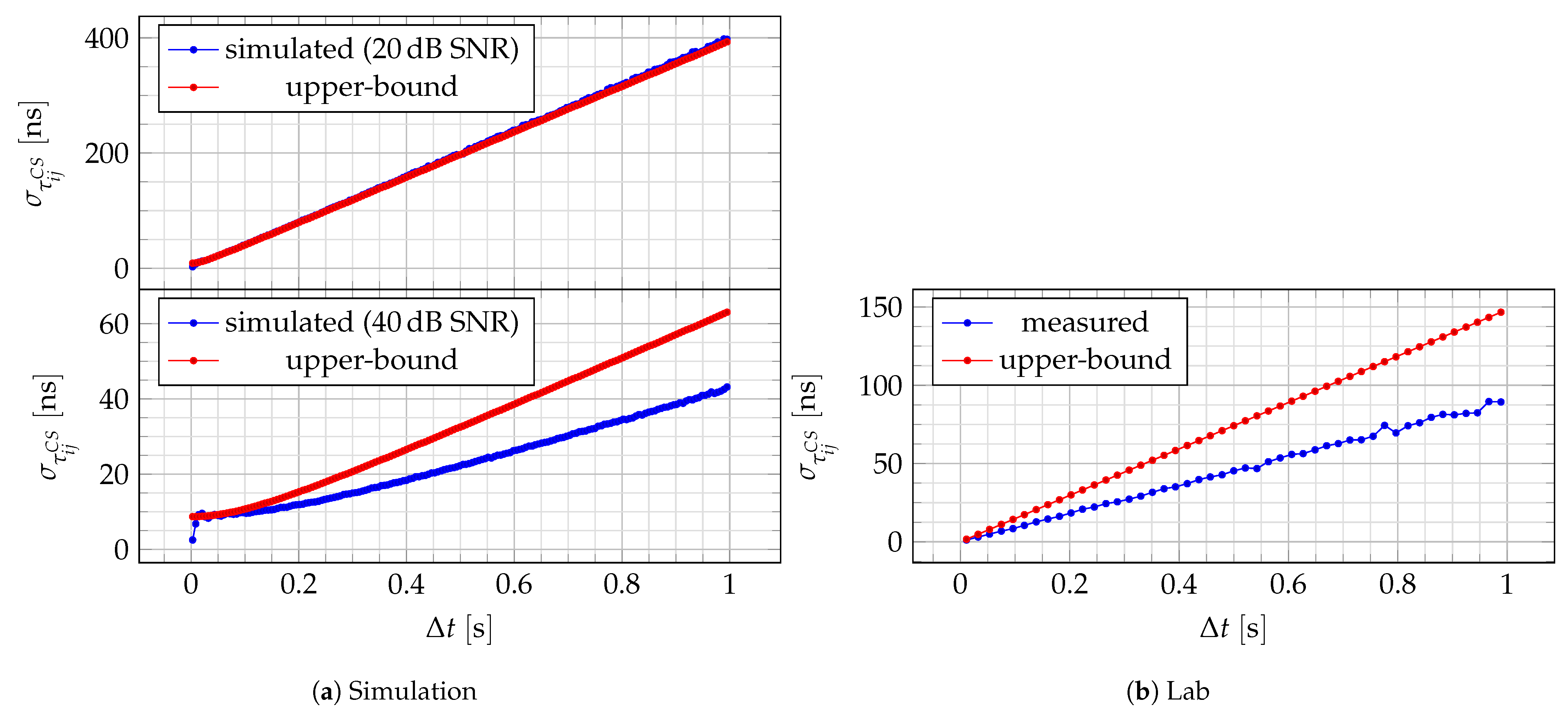
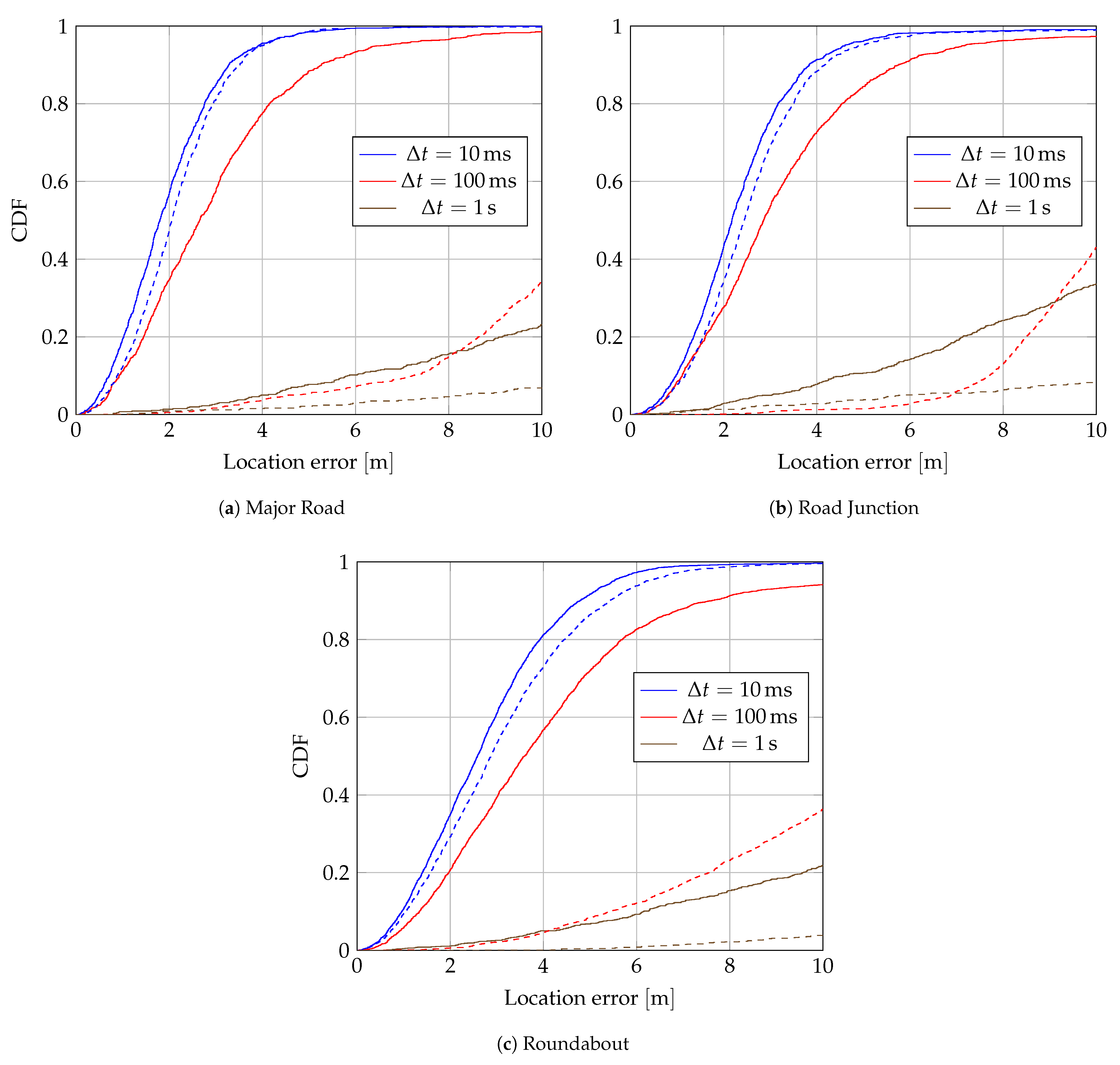
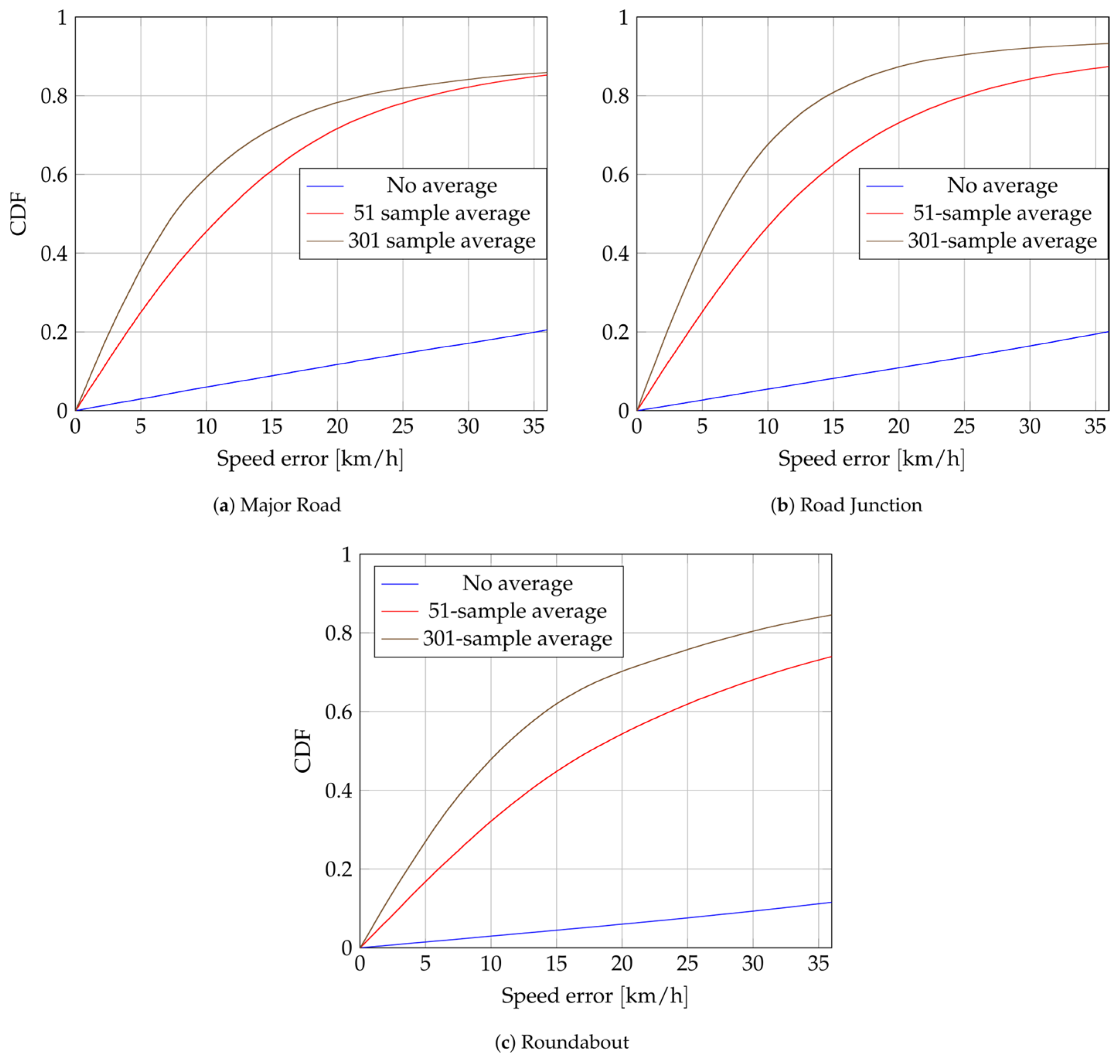
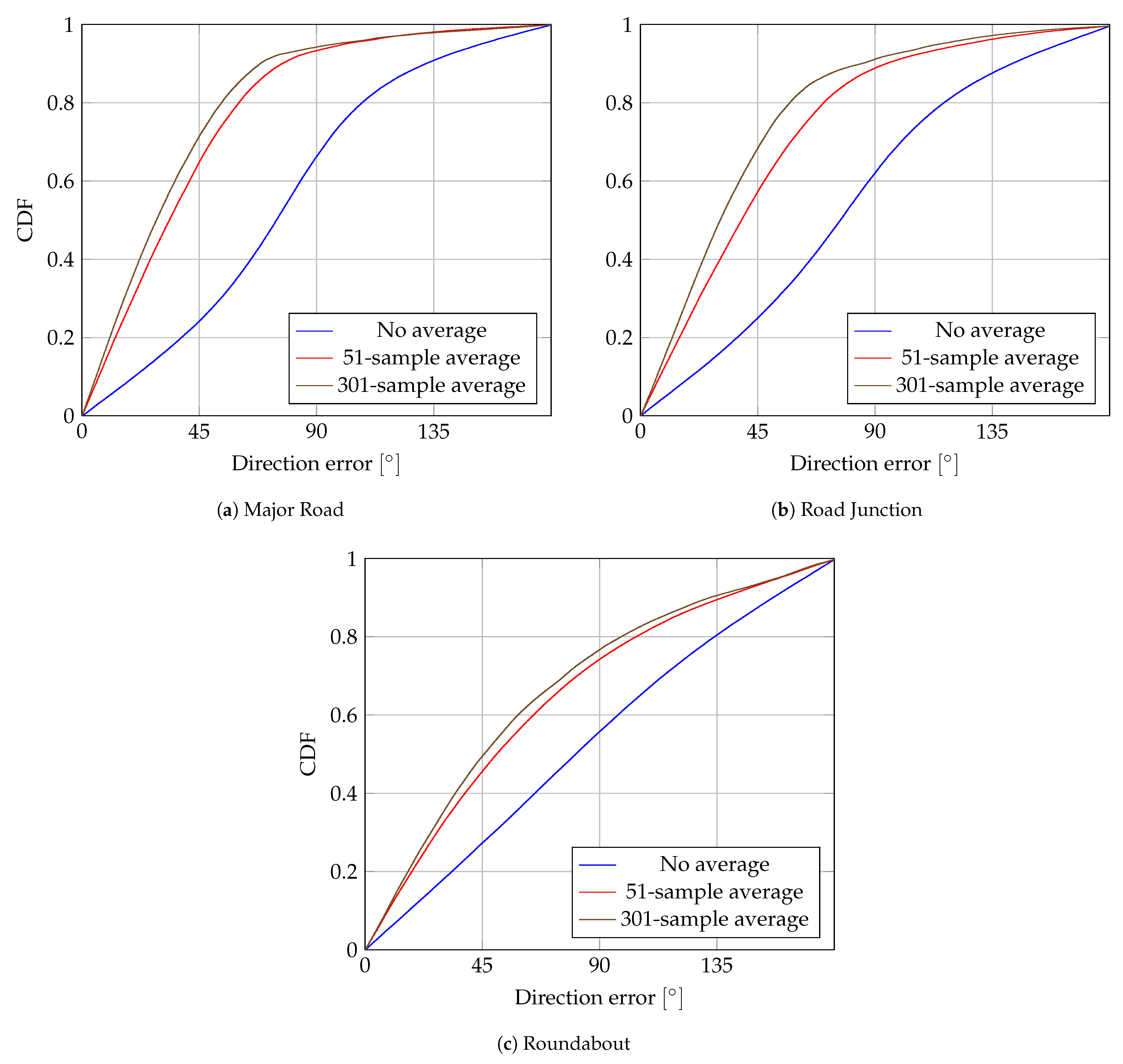
| sim | lab | exp | |
|---|---|---|---|
| 2 / | 2.5 / | 2.5 / | |
| 4.235 × 10−20 | - | - | |
| 2.755 × 10−16 | - | - | |
| T | 2 | - | - |
| 2 | 10 | 10 | |
| 1 | 10 | 10 | |
| 20 | 40 | 40 | |
| 500 | 24 | 100 | |
| 2.35 | 2.35 | 2.35 | |
| 2.55 | |||
| 20 | 20 | 20 | |
| 100 | 100 | ||
| SNR | 40 dB | - | - |
| MR | RJ | RA | |
|---|---|---|---|
| No averaging | 560 | 440 | 610 |
| 51-sample average | 90 | 80 | 110 |
| 301-sample average | 50 | 40 | 60 |
Disclaimer/Publisher’s Note: The statements, opinions and data contained in all publications are solely those of the individual author(s) and contributor(s) and not of MDPI and/or the editor(s). MDPI and/or the editor(s) disclaim responsibility for any injury to people or property resulting from any ideas, methods, instructions or products referred to in the content. |
© 2024 by the authors. Licensee MDPI, Basel, Switzerland. This article is an open access article distributed under the terms and conditions of the Creative Commons Attribution (CC BY) license (https://creativecommons.org/licenses/by/4.0/).
Share and Cite
Hannotier, C.; Horlin, F.; Quitin, F. A CFO-Assisted Algorithm for Wireless Time-Difference-of-Arrival Localization Networks: Analytical Study and Experimental Results. Sensors 2024, 24, 737. https://doi.org/10.3390/s24030737
Hannotier C, Horlin F, Quitin F. A CFO-Assisted Algorithm for Wireless Time-Difference-of-Arrival Localization Networks: Analytical Study and Experimental Results. Sensors. 2024; 24(3):737. https://doi.org/10.3390/s24030737
Chicago/Turabian StyleHannotier, Cédric, François Horlin, and François Quitin. 2024. "A CFO-Assisted Algorithm for Wireless Time-Difference-of-Arrival Localization Networks: Analytical Study and Experimental Results" Sensors 24, no. 3: 737. https://doi.org/10.3390/s24030737
APA StyleHannotier, C., Horlin, F., & Quitin, F. (2024). A CFO-Assisted Algorithm for Wireless Time-Difference-of-Arrival Localization Networks: Analytical Study and Experimental Results. Sensors, 24(3), 737. https://doi.org/10.3390/s24030737






